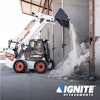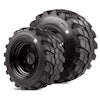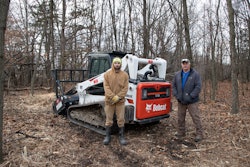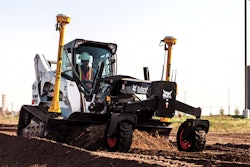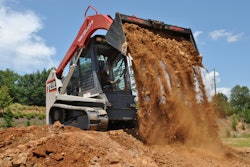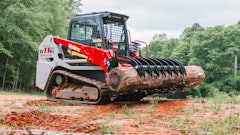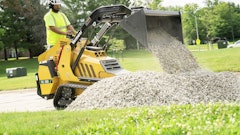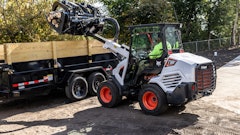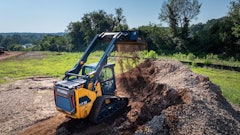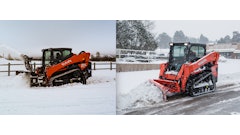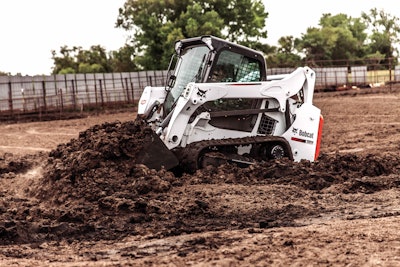
Compact track loaders (CTLs) are one of the “go-to” pieces of equipment many contractors choose for working in extreme ground conditions. By design, their long track offers traction, flotation and stability for working in muddy conditions, moving on steep slopes and inclines and over rocky terrain.
The tracks and undercarriage are the CTL’s first line of defense for conquering rugged underfoot environments.
“It all comes down to the tracks and the undercarriage,” says Brad Stemper, solutions marketing manager, Case Construction Equipment. “CTLs distribute their weight evenly over the length and width of the tracks so they’re able to handle uneven terrain more efficiently. They provide a stable platform that improves material hauling, grading and attachment use. Their primary advantage is lower ground pressure and stable operation over uneven surfaces, as the tracks provide more contact with the ground than four independent tires.”
CTLs can also extend the work season with their flotation characteristics, says Jorge De Hoyos, senior product manager, skid steers and compact track loaders, Kubota Tractor Corporation. “A little rain isn’t going to stop them,” he says. “Their undercarriage also makes them heavier than wheeled units, and thus more stable. Collectively, low ground pressure and heavier weight have been perennial advantages of CTLs.”
Get a Grip on Compact Track Loader Undercarriage Options
Manufacturers build in additional features that boost performance in less than ideal ground conditions.
For example, Bobcat models with Selectable Joystick Controls feature horsepower management that allows the machine to control engine rpm, torque and fuel injection. “It retains drive torque to the tracks better, especially in muddy conditions,” says Eric Dahl, loader product specialist, Bobcat. “If the operator is working the machine hard, horsepower management will control the engine torque so the operator is always operating in the peak torque range for that machine. Without it, you could potentially overwork the loader and stall out in difficult conditions.”
Bobcat also balances its machines with a 60:40 (rear/front) weight ratio. “At a 50:50 ratio, the machine is more ‘flat footed,’” Dahl says. “It takes more horsepower to turn in those conditions. Balancing it 60:40 reduces the amount of horsepower required when working in difficult environments.”
Options such as ride control can further enhance performance. “We strongly recommend owners get the ride control option,” says Stemper. “It is a boom dampening feature, activated at the push of a button, that helps minimize spillage and rough travel over varied terrain. It also makes the ride smoother on the operator.”
Extreme Condition Precautions
While CTLs are designed for challenging conditions, operators should still take precautions before, during and after each shift to minimize premature wear and tear on components.
Treat the CTL undercarriage with the same care as larger steel tracked machines, advises Stemper. “An important part of this is the pre- and post-operation walk-around,” he notes. “Clear dirt, mud and rocks from the undercarriage, because these materials can cause premature wear during operation.”
Mud packed in and around sprockets and idlers will also reduce performance. “When sprockets are turning against the mud, the additional friction robs the machine of horsepower,” Dahl explains. “If you are working in muddy conditions, you may have to stop and clean out the tracks during operation.”
David Steger, national product and training manager, Takeuchi-US, emphasizes the importance of performing a high/low inspection to identify potential hazards prior to use. “Before operating on any site, a thorough inspection is critical,” he states. “This is especially true when conditions are extreme, because you may be less likely to properly inspect the area for possible hazards like ledges, severe slopes, soft ground and other conditions. Also be aware of any above-ground or overhead utilities that may be in close proximity. Surface inspection is just as important as underground hazard location.”
Working around water can present some unique hazards. “Ledges, water depth and undercut banks are just some things to check for,” says Steger. “Crossing shallow water is sometimes necessary, and like all other operations, you should know the terrain, including water depth, bottom conditions and currents. If you do cross water, never exceed the water depth allowed by the manufacturer and never let the engine, fan or electrical components come into contact with the water.”
Extreme temperatures can also influence machine performance and component life. “If you are working in colder temperatures, always make sure the machine is warmed up properly,” says Dahl. “You may also need to change to synthetic oils and hydraulic fluid.”
Steger recommends limiting idling, as well as ensuring the undercarriage is relatively clean to prevent freezing of track or undercarriage components. “Make sure you have good visibility through the glass,” he adds, “and be aware that wet or frozen ground (or vegetation) can cause slippery conditions, turning a gentle slope into an extreme condition in some scenarios.”
Stemper cautions against parking a CTL in an area where its rubber tracks could freeze to the ground. “We’ve seen machines locked in place where an operator parked in a soft spot during the day, which then froze overnight,” he notes.
“In extreme cold conditions, the critical component is the rubber belt tread, which can pack with snow or ice. The CTL ends up spinning on its tracks,” says De Hoyos. “Aggressive belts can help shed that snow and ice a lot better than typical offset lug pattern treads.”
Working in extremely hot temperatures requires special attention, as well. “CTL undercarriages generally do well in extreme hot conditions as long as idlers are sealed and lubricated,” says De Hoyos.
Make sure screens, air intake and coolers are clean and clear of debris, adds Steger. “Keep an eye on operating temperatures of engines and hydraulic components, especially when operating hydraulic attachments which can, in some cases, place more load on the machine,” he adds.
Operational Tips
The beauty of a CTL is that it can operate in conditions that might sideline other pieces of equipment. However, it’s best to stick to relatively flat surfaces if possible, says Stemper, since operating the machine with the outside/inside edge of the track turned up can cause damage to the edges and lugs of the rubber track.
If slopes or soft ground can’t be avoided, take proper precautions. “Respect the terrain,” says Steger. “Slopes and soft ground can cause the machine to tilt or move, causing a shift in gravity. It can also impact the operating capacity of the machine.”
While traversing up and down a slope face is possible, it will be limited by the machine’s capabilities and the load/attachment. According to Steger, this is generally limited to 30°, or slightly steeper than a 2:1 slope. “Traveling across a slope should be eliminated, if possible; but when necessary, you must follow the procedures outlined in the operator’s manual,” he states. “This is often limited to 10°, or approximately a 6:1 slope.”
Also, keep the heavy end of the machine pointed uphill. “When the bucket is full, that would be the front end, and when the bucket is empty the rear of the machine would be the heaviest end,” notes Dahl.
Speed has a lot to do with maintaining machine control. As such, Steger recommends traveling with the load low and at a safe speed for the conditions.
“Operators should know the machine’s capabilities and should operate in a smooth and controlled manner. Keep loads low to the ground and avoid sudden stops or jerky operation,” adds De Hoyos.
Attachments and loads can dramatically change operating practices, as well. “For example, when using a pallet fork, the rated operating capacity will shift because the center of gravity shifts with the front load,” says De Hoyos. “Operators need to take a different approach than when using a bucket.”
Training in safe CTL operation is important, as is experience. The ability to adapt operation to challenging conditions comes with time behind the controls.
“For example, a newly licensed teenage driver may be capable of safely driving a few miles to school,” says Steger. “However, the same driver may not necessarily be qualified to drive a pickup truck and small travel trailer through a mountain pass. Both involve driving a vehicle, but one requires much more skill than the other and the risks can be greater.”
Know How Much is Too Much
Given their advantages in flotation, traction and stability, it may be tempting to use a CTL in any conditions. However, there can be situations that are too much even for them.
“The great thing about CTLs is that they can go where many other machines can’t due to their greater flotation and relatively lighter weight,” says Stemper. “The key is not to get too bold. For instance, while these machines are excellent working in swampier conditions and near bodies of water, it’s important not to get too close and get stuck. Similarly, while CTLs are great for working in uneven terrain, it might not be ideal for them to work in environments like quarries where the excessive presence of rocks and jagged material can wreak havoc on the rubber tracks.”
De Hoyos urges precautions in certain surface conditions, as well. “Obviously, the ground surface is critical, as most rubber tracks are not meant to constantly run on hard and aggressive surfaces like concrete, caliche or rock,” he states. “When used in these tough surfaces, the rubber belts wear faster.
“On these surfaces,” he concludes, “a wheeled machine will do better.”

